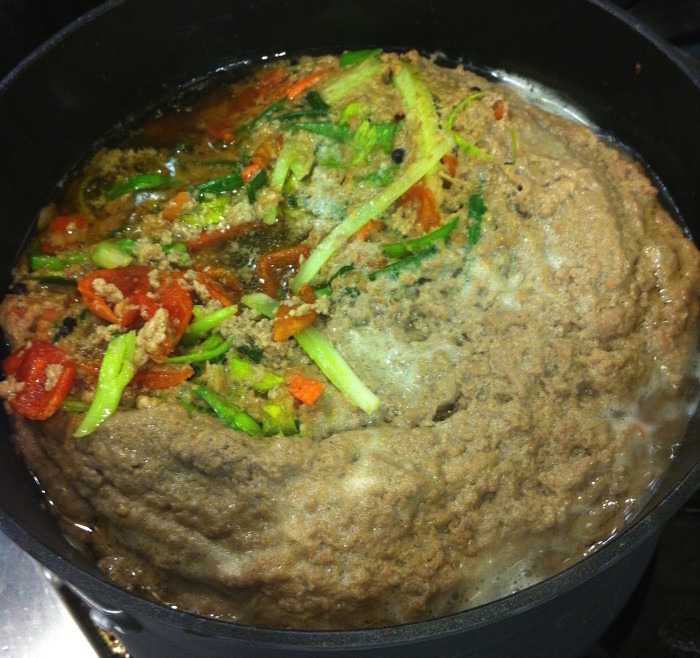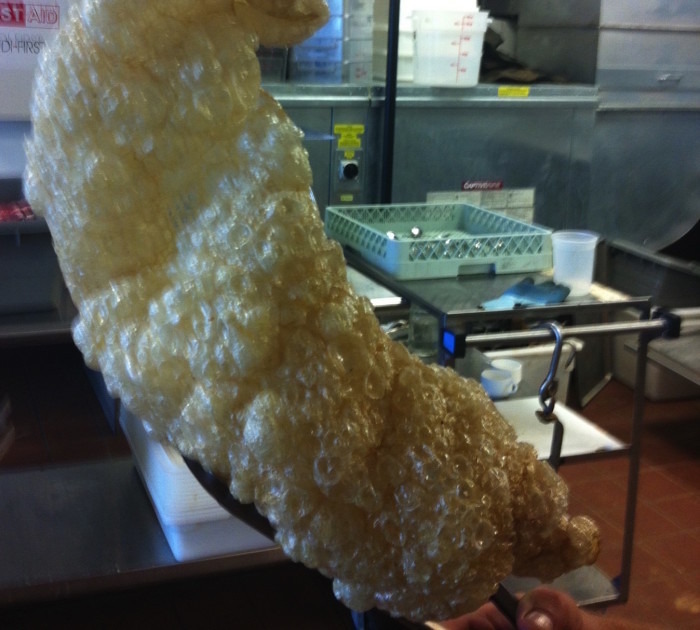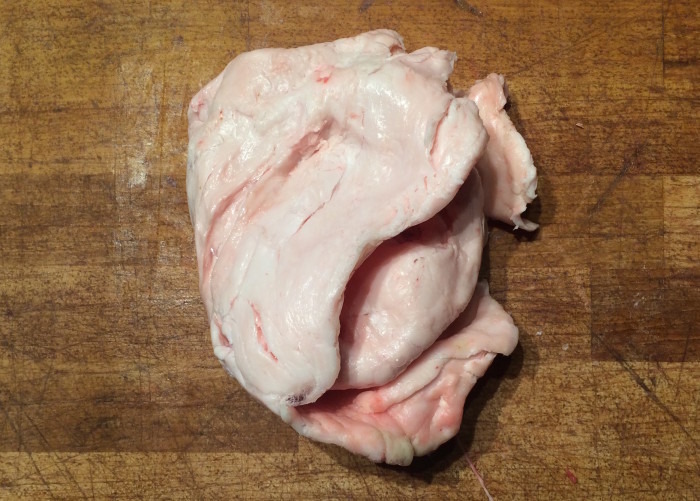Here's Why You Should Be Cooking With Bones, Fat And Skin
Food Republic's column Ask Your Butcher seeks to answer FAQs in the world of butchery. Ethically minded butcher Bryan Mayer founded Philadelphia's Kensington Quarters and helped develop a renowned butcher-training program at Brooklyn's Fleisher's. Today, he consults with farmers, chefs, butchers and anyone else who will listen. In each column, Mayer tackles a pressing issue facing both meat buyers and home cooks. Here, he explores three things that you probably aren't cooking with now, but you should.
Peer over the counter at your local whole-animal butcher shop and you're more than likely going to see a whole lot of bones, fat and — depending on the animal — skin. And while our more industrially focused brethren don't have to take much of this into consideration (being that you can order up just about anything skinless, boneless, and pretty much denuded of any and all fat), we who preach whole-carcass utilization take this as a challenge!
Our detractors would say that the industrial model is nothing if not efficient when it comes to utilizing the whole carcass. And that's somewhat true, if you exclude certain parts that are routinely discarded due to their lack of economic viability. While I've read more than my fair share of blog posts pointing out that we, the so-called whole-animal butchers who claim to use everything but the oink, often fall short of these claims, it does bear mentioning that we are severely limited in what we actually receive from our slaughterhouses.
The limitations of these by-products, both edible and inedible, are not totally based on legality, but rather on a significant revenue stream for slaughterhouses. And rightfully so. Up until very recently, very few people in the U.S. were looking to prepare a traditional Burns Supper, which, among other things, calls for stomach and lung, the latter being a by-product that is illegal in the U.S. But what of all those bones going into that bone broth, or, as I like to call it, stock? It's as if they magically appeared, to cure all your ailments, from gut issues to hair loss to nonexistent love life.
In fact, the list of uses for animal by-products — again, both inedible and edible — is endless. Here's a sample, courtesy of the U.S. Department of Agriculture:
Adhesives, ceramics, cosmetics, feed use, fertilizer, foam in fire extinguishers, insecticides, buttons and handles, capsules for medications, emulsions, gelatins, glues, hardening steel, candies, dairy products, ointments, paper, photographic films, refining sugar, textiles, candies, chewing gum, germicides, industrial oils, lubricants, soap, glycerin, shortenings, tires, athletic equipment, brushes, felt, insulation, rugs, upholstery.
Sorry, vegans.
I'm hoping now you can see why these things are hard to come by, and more importantly, why they have such value. To put it all into context for you, by-products account for roughly 30 percent of the live weight (weight before slaughter and evisceration) of hogs and roughly 44 percent of the live weight of cattle. To devalue these items would ultimately mean devaluing the work of our farmers. We don't want to do that.
With the proliferation of whole-animal butcher shops, we are starting to see an increased interest in using more by-products, specifically bones, fat and skin. So here are a few cooking ideas:
Bones

Auguste Escoffier once said, "Indeed, stock is everything in cooking. Without it, nothing can be done." And since my grandma used it as a cure-all, I'm not one to disagree. Stocks contain minerals in a form that the body can absorb easily — not just trace minerals, but sulfur, magnesium and calcium. Add to that the stuff in cartilage, like chondroitin and glucosamine, and you're liable to put GNC out of business. And while it's easy to poke fun of your local dispensary, pouring cups of $9 broth from stainless steel urns, there clearly is some merit to this craze — certainly more so than kale!
Feel free to use any types of bones you'd like: neck, knuckle (the ends of long bones) and marrow all work great. Go ahead and experiment. Step outside the comfort zones of beef and chicken! Try lamb, goat and pork, and add any spices you wish. After all, it's about what tastes good to you. For my simple beef stock, I add a bit of salt, ginger, clove and turmeric. You can simply simmer bones and water, or go ahead and make a full-on stock by adding your standard mirepoix. Or, in my case, suppengruen, to honor my German side.
Basic Beef StockIngredients
Roughly 4 pounds of neck, knuckle, and/or marrow bones
4 quarts water (or enough to cover bones)
3 each celery, carrots and onions, if desired
Directions:
Skin

It's one of largest organs, if not the largest. You could say it's one of the most important. It keeps the body safe from the extremes of temperatures, sunlight and chemicals. And if you're a hog or a chicken, it also happens to be delicious. Roast a whole chicken in my house and someone's picking off the crispy skin. Braise a picnic ham for pernil and that crispy skin is a great counterbalance to the tender meat. Skin alone, especially from pigs, has many uses. Aside from all the inedible examples mentioned above, it's great to add skin to stocks. All that gelatin that it contains is a great thickener. It can make great noodles, and, of course, there's the ol' standby, chicharrónes.
Preparing pig skin for noodles is a bit of a process and removes something very dear to me and hopefully to you: pork fat. What you're left with is something reminiscent of pasta, but with an obvious porkiness that is an excellent addition to any ramen. You'll want to denude the skin of any fat and hair, add some salt and allow it to cure for a couple of hours. You can prepare a marinade, which is something that will help break down the skin over a 24-hour period. Once that's done, you'll want to cook for a couple more hours, cool for another 12 and you're ready to add to your ramen. Yeah, that's a lot of work.
Let's stick to a chicharrón. I like my chicharrónes the way my mother-in-law does them: not the puffed, airy kind, but something with a bit more substance — some meat and some fat. The seasoning isn't necessarily the important part here, but the process is, as you'll want to follow it closely in order to get a crispy, crunchy chicharrón.
You're still going to have to put in some time with this one, but you can make a few batches to sit up on your shelf (it's right next to the granola on mine). I like to use pork belly for this as it has the best ratios of skin, meat and fat. I'll use a little baking soda with my salt, as I cure the belly overnight. This will help with dehydration, which is important in order to achieve that crunchy skin. After your 24-hour cure, you're ready to cook. Grab a large skillet and add some water for the wet-rendering method. This is much more forgiving than the dry method and the water will also help to braise the bit of meat and slowly render the fat over 3 to 4 hours. You'll know when all the water has evaporated and you're left with just rendered fat when you cease to see any bubbles rising. You're all set to crank the heat to high and fry away, which should take about three to five minutes. Transfer to a paper towel–lined plate to cool a bit and then add some vinegar, preferably some Sukang Maanghang.
Chicharrón Baboy (Filipino Pork Rind Cracklings)Ingredients
1 pound pork belly
2 teaspoons baking soda
1 teaspoon salt
Water to cover
Vinegar
Directions:
Fat

Since we briefly mentioned fat above, why don't we really talk about it for a moment here? Fat has been vilified for far too long. Whether it was Sinclair's fictional account of the horrors of rendering plants, Procter and Gamble's marketing campaign for Crisco and the newly invented process of hydrogenation in the early 20th century, or scientists in the 1950s all but singling out animal fat as the cause of heart disease, it seemed we had good reason to avoid animal fats at any cost.
Well, that cost is our health. Fats from animals — consumed in moderation, of course — provide a concentrated source of energy in our diet, a source that cannot be supplemented. They are the building blocks for cell membranes and hormones. As if that weren't enough, they are also the carriers for the extremely important, fat-soluble vitamins A, D, E and K. Fat doesn't only taste good — it is now recognized as the sixth taste — but it does good for you! And not just animal fats. We're talking oils: extra-virgin olive oil, unrefined flaxseed oil, and coconut oil, for example. Keep on using all that butter, which is hopefully from grass-fed, fully pastured cows!
Good oils and butter are fairly easy to come by these days. As for rendered animal fat, that's a bit tricky. Your whole-animal butcher shop should have some already rendered for you. If not, you can always purchase a hunk of fat from them and render it yourself. Pork fat is the best, as it's the most neutral of fats, but feel free to use beef, chicken or whatever you'd like. You'll need a skillet, some water and a little bit of time — that's all. You'll want to cube the fat or, if possible, coarsely grind it to speed the process up a bit. I like the wet-rendering method, as you're less likely to scorch the fat. While scorching won't necessarily ruin the fat, it will definitely bring out the flavors a bit more in your lard, which is something that you may not want in a flaky pie crust. A low flame, and once the bubbles stop rising, you've got pure fat ready to fry potatoes or make some chicharrónes.
Rendered FatThis can be as easy as removing some of the visceral fat from the chicken you're about to roast or going to your local whole-animal butcher to order some pasture-raised animal fats.Directions:

